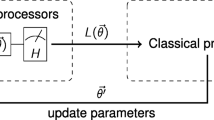Abstract
A quantum-implementable neural network, namely quantum probability neural network (QPNN) model, is proposed in this paper. QPNN can use quantum parallelism to trace all possible network states to improve the result. Due to its unique quantum nature, this model is robust to several quantum noises under certain conditions, which can be efficiently implemented by the qubus quantum computer. Another advantage is that QPNN can be used as memory to retrieve the most relevant data and even to generate new data. The MATLAB experimental results of Iris data classification and MNIST handwriting recognition show that much less neuron resources are required in QPNN to obtain a good result than the classical feedforward neural network. The proposed QPNN model indicates that quantum effects are useful for real-life classification tasks.














Similar content being viewed by others
References
Nielsen, M., Chuang, I.: Quantum Computation and Quantum Information. Cambridge University Press, Cambridge (2000)
Shor, P.: Polynomial-time algorithms for prime factorization and discrete logarithms on a quantum computer. SIAM J. Comput. 26(5), 1484–1509 (1997)
Childs, A.M., Landahl, A.J., Parrilo, P.A.: Quantum algorithms for the ordered search problem via semidefinite programming. Phys. Rev. A 75, 032335 (2007)
Farhi, E., Goldstone, J., Gutmann, S., Lapan, J., Lundgren, A., Preda, D.: A quantum adiabatic evolution algorithm applied to random instances of an NP-complete problem. Science 292, 472 (2001)
Murphy, K.P.: Machine Learning: A Probabilistic Perspective. MIT Press, Cambridge (2012)
Cristina Diamantini, M., Trugenberger, C.A.: High-capacity quantum associative memories (2015). arXiv:1506.01231v1
Schuld, M., Sinayskiy, I., Petruccione, F.: An introduction to quantum machine learning. Contemp. Phys. 56(2), 172–185 (2015)
Wiebe, N., Kapoor, A., Svore, K.: Quantum deep learning. arXiv preprint arXiv:1412.3489 (2014)
Wiebe, N., Braun, D., Lloyd, S.: Quantum algorithm for data fitting. Phys. Rev. Lett. 109, 050505 (2012)
Lloyd, S., Mohseni, M., Rebentrost, P.: Quantum algorithms for supervised and unsupervised machine learning (2013). arXiv:1307.0411
Menneer, T., Narayanan, A.: Quantum artificial neural networks vs classical artificial neural networks: experiments in simulation. In: Proceedings of the IEEE Fourth International Conference on Computational Intelligence and Neuroscience, pp. 757–759 (2000)
Ventura, D., Martinez, T.: Quantum associative memory. Inf. Sci. 124(1–4), 273–296 (2000)
Pagiamtis, K., Sheikholeslami, A.: Content-addressable memory (CAM) circuits and architectures: a tutorial and survey. IEEE J. Solid State Circuits 41(3), 712–727 (2006)
Behrman, E.C., Nash, L.R., Steck, J.E., Chandrashekar, A.A., Skinner, S.R.: Simulations of quantum neural networks. Inf. Sci. 128(3), 257–269 (2000)
Panella, M., Martinelli, G.: Neural networks with quantum architecture and quantum learning. Int. J. Circuit Theory Appl. 39, 61–77 (2011)
Schuld, M., Sinayskiy, I., Petruccione, F.: The quest for A quantum neural network. Quantum Inf. Process. 13(11), 2567–2586 (2014)
Sahni, V., Patvardhan, C.: Iris data classification using quantum neural networks. In: AIP Conference Proceedings, vol. 864, p. 219 (2006)
Fei, L., Baoyu Z.: A study of quantum neural networks. In: IEEE International Conference on Neural Networks and Signal Processing, December (2003)
Weinberg, S.: Precision tests of quantum mechanics. Phys. Rev. Lett. 62, 485–488 (1989)
Silva, A.J.D., Ludermir, T.B., Oliveira, W.R.D.: Quantum perceptron over a field and neural network architecture selection in a quantum computer. Neural Netw. 76, 55–64 (2016)
Schuld, M., Sinayskiy, I., Petruccione, F.: Simulating a perceptron on a quantum computer (2014). arXiv:1412.3635
Iris flower data set. https://en.wikipedia.org/wiki/Iris_flower_data_set
THE MNIST DATABASE of handwritten digits website. http://yann.lecun.com/exdb/mnist/
Chen, J., Wang, L., Charbon, E., Wang, B.: A programmable architecture for quantum computing. Phys. Rev. A 88, 022311 (2013)
Brown, K.L., Thesis, P.D.: Using the Qubus for Quantum Computing. University of Leeds, Leeds (2011)
Jesse, A.: Garman: A Heuristic Review of Quantum Neural Networks, master paper of Imperial College London (2011)
Brassard, G., Hoyer, P., Mosca, M., Tapp, A.: Quantum amplitude amplification and estimation (2000). arXiv:quantum-ph/0005055
Spiller, T.P., Nemoto, K., Braunstein, S.L., Munro, W.J., van Loock, P., Milburn, G.J.: Quantum computation by communication. New J. Phys. 8, 30 (2006)
Raussendorf, R., Briegel, H.J.: A one-way quantum computer. Phys. Rev. Lett. 86, 5188 (2001)
Raussendorf, R., Browne, D.E., Briegel, H.J.: Measurement-based quantum computation with cluster states. Phys. Rev. A 68, 022312 (2003)
Shende, V.V., Bullock, S.S., Markov, I.L.: Synthesis of quantum logic circuits. In: IEEE Transaction on CAD, vol. 25, no. 6 (2006)
Shwartz, S.S., David, S.B.: Understanding Machine Learning. Cambridge University Press, Cambridge (2014)
Deng, L.: The MNIST database of handwritten digit images for machine learning research. IEEE Signal Process. Mag. 29, 141 (2012)
Srivastava, N., Hinton, G., Krizhevsky, A., Sutskever, I., Salakhutdinov, R.: Dropout: a simple way to prevent neural networks from overfitting. http://jmlr.org/papers/v15/srivastava14a.html, http://www.cs.toronto.edu/~hinton/absps/dropout.pdf
Author information
Authors and Affiliations
Corresponding author
Rights and permissions
About this article
Cite this article
Chen, J., Wang, L. & Charbon, E. A quantum-implementable neural network model. Quantum Inf Process 16, 245 (2017). https://doi.org/10.1007/s11128-017-1692-x
Received:
Accepted:
Published:
DOI: https://doi.org/10.1007/s11128-017-1692-x




